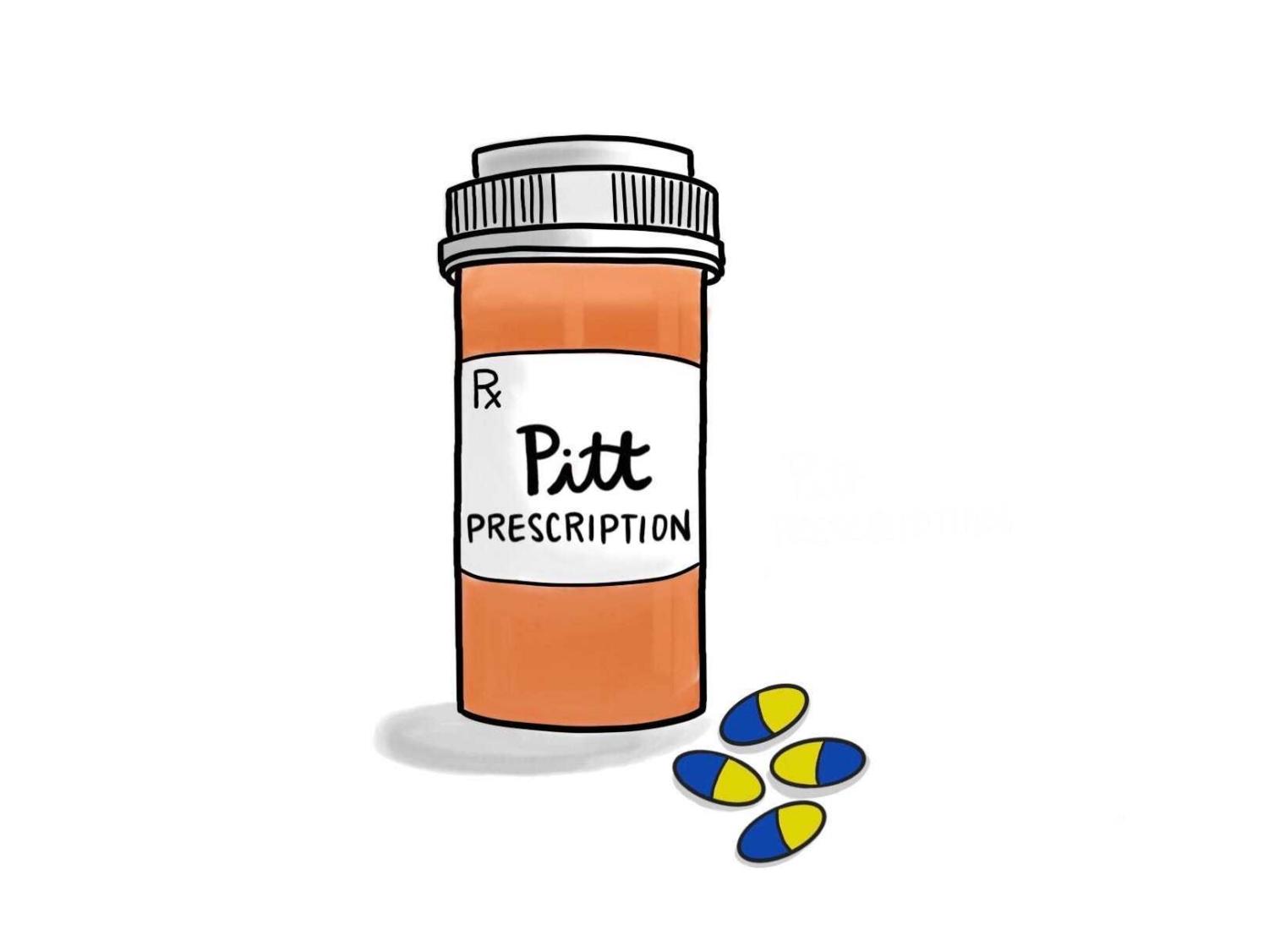The Pitt Prescription | The need to know about naloxone


The Pitt Prescription
Substance use disorder is something people don’t often explicitly talk about on college campuses. SUD is a type of mental health disorder that may affect someone’s brain and behavior, leading to an inability to control their intake or use of substances such as alcohol or drugs. The most severe form of SUD is full addiction, but there are other more moderate symptoms of SUD that may appear.
You may have heard about the current “opioid epidemic” plaguing many areas in the United States, and Pennsylvania is not exempt from this. Opioids are medications that work in the brain to provide relief for moderate to severe pain, and there are many different types. Some are prescription medications, such as morphine and oxycodone, but street drugs like heroin and illegally manufactured fentanyl are also opioids. Although opioids are typically used for pain management, they also produce sedating effects and can cause people to feel “high,” which contributes to their addictive potential.
In 2017, there were 5,456 drug-related overdose deaths in Pennsylvania. This represents a rate of 43 deaths per 100,000 people, almost double the national average of 22 overdose deaths per 100,000 people. There is a high availability of illicit and prescription opioids in Pennsylvania, which leads to higher rates of opioid misuse regardless of geographic or demographic boundaries.
While SUD is a complex disorder that requires intense management and multiple care components, a major intervention that has assisted with overdoses is naloxone. Naloxone — aka Narcan — is a medication that can reverse opioid overdoses for both prescription medications and illicit opioids like heroin. It is most frequently given as a nasal spray, which makes it safe and user-friendly.
Naloxone can also be administered as an injection into muscle or under the skin using an auto-injector that speaks directions, similar to an epipen. Interviews with drug users and treatment personnel showed that the widespread availability and use of naloxone has resulted in many lives saved.
According to the Centers for Disease Control and Prevention, almost 50,000 people died from opioid-related overdoses in 2019. They found that bystanders were present in more than one in three opioid overdoses. The CDC believes that if these bystanders have the right tools on hand, like naloxone, they can use them and potentially save someone’s life.
It’s important to note that naloxone will not cause harm to someone if they are overdosing on something other than opioids or experiencing a different medical emergency. Because of this, it’s always best to use naloxone, when available, if there is even a chance someone is experiencing an overdose.
Naloxone is not only beneficial for illicit opioid use. Any person who is legally prescribed opioids and takes them as their provider directs may be at risk for overdose. Opioids are strong medications, and sometimes issues may arise even when taking them as directed. Due to this risk, the CDC recommends that anyone taking high-dose prescription opioids should have naloxone on them at all times.
This recommendation also applies to anyone who uses opioids and benzodiazepines like Ativan together, someone who struggles with opioid use disorder or someone who uses illicit street opioids like heroin. It is also important to let others know if you have naloxone handy, since you can’t use it on yourself and need someone else to administer it to you if an overdose does occur.
A 2020 National Institutes of Health study found that the lifetime estimate for prescription opioid misuse among the general college population ranged from 4% to 19.7%. The researchers concluded that the opioid epidemic is an urgent issue that affects people from all age groups, including college students. Even if you do not use opioids, there is a good chance you know someone who does. Therefore, it is important for everyone to learn the signs of overdose and how to administer naloxone.
There are several key signs to look for when evaluating if somebody is experiencing an opioid overdose. Signs include blue skin especially on the lips and fingertips, a limp body, pale face, slow or irregular breathing, small pupils, complete lack of breathing, slow or erratic pulse, loss of consciousness, vomiting or the person is conscious but unable to respond.
Naloxone nasal spray is the most commonly seen dosage form, and it’s simple to administer. If you believe someone is experiencing an overdose, immediately call 911. Then, if naloxone spray is available, open the spray and hold it with your thumb on the bottom plunger. Tilt the impaired person’s head back and gently insert the spray into their nose until your fingers touch the base of their nostrils. Firmly push the plunger with your thumb to administer the medication. Wait two minutes and if they do not respond, repeat these steps.
Once they respond, roll them on their side to the recovery position and wait with them until emergency medical help arrives. Withdrawal symptoms such as sweating, nausea, vomiting and rapid heart rate may occur after naloxone administration, but these are not life threatening. The risk of death from an overdose is far worse than having withdrawal symptoms after the administration of naloxone.
Watch how to administer naloxone spray here:
In Pennsylvania, individuals who are at risk of opioid overdose can get naloxone at their local pharmacy either using a prescription from their provider or by utilizing the current PA Standing Order. This standing order is a prescription written for the general public by the Physician General, Dr. Denise A. Johnson, and is an attempt to make naloxone more easily accessible to everyone who may need it. Some insurance plans will cover the entire cost of the treatment, but if not, there are some community-based organizations that may be able to help at-risk individuals obtain naloxone for free, including local county health departments.
Although naloxone may be a life-saving treatment for opioid overdose, there are a lot of other factors that come into play. The CDC recommends calling 911 after administration of naloxone because its effects could wear off and the person could go back into their overdose. In Pennsylvania, the Good Samaritan provision provides legal protection to people who administer naloxone to someone experiencing a drug-related overdose. This law was created with hopes of minimizing people’s fear of legal repercussions if they act in good faith and call emergency medical services during an overdose.
There are many treatment options available for people who suffer from opioid use disorder or other forms of SUD. If you or someone you know is struggling, there are resources available online and at your local County Drug and Alcohol Office. Pennsylvania has a free website and phone number (1-800-622-4357) designed to help people find treatment programs.
Naloxone is a great tool for emergency situations, but it should not be used as a crutch. SUD and addiction are real illnesses and should be treated as such. While it may be difficult or uncomfortable to have conversations about these topics, it could end up saving a life.
Elizabeth writes primarily about self-care and pharmacological topics. For questions, comments or concerns, you can reach her at ead85@pitt.edu.
Recent Posts
Pitt loses overtime thriller to Clemson, drops fourth straight ACC game
Pitt men’s basketball (12-6, ACC 3-4) dropped its fourth straight game 78-75 to Clemson (14-4,…
Former Panther, “Bub” Carrington making magic with Washington Wizards
With first-overall pick Alex Sarr, the rise of sophomore and once-lottery pick Bilal Coulibaly and…
What, Like It’s Hard? // The waiting game
After a long winter break, contributing editor Livia LaMarca reflects on her time waiting for…
From Pop to Personal // Flu, Football and Fresh Starts
On this edition of From Pop to Personal, staff writer Ashley O’Doherty compares herself to…
Who Asked? // Do we secretly like cheaters?
This installment of Who Asked? by staff writer Brynn Murawski notices how common it is…
Couch Critic // Space movies: An unexpected comfort
In this week's Couch Critic, Emily Harris explores her newly discovered niche for space movies…


